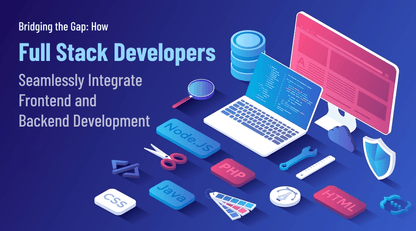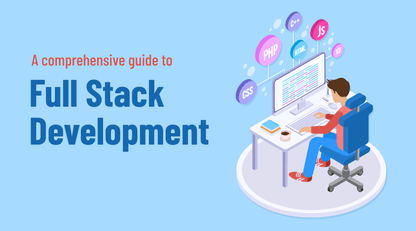If you're looking to add a full-stack developer to your team in 2024, you're making a smart move. Full-stack engineers are invaluable parts of any team - they can handle front-end, back-end, database and everything in between.
But skilled full-stack developers are in high demand, so hiring one can get expensive.
In this blog, we'll break down everything that goes into the cost of hiring full-stack developers, so you can budget properly.
What Does a Full-Stack Developer Do?
Before we dig into numbers, let's look at what full-stack developers actually do day-to-day.
Full-stack developers are involved in every phase of building an application or website.
-
On the front-end, they code user interface elements and connect them to back-end systems.
-
On the back-end, they build APIs, databases, servers and application logic. Full-stackers are comfortable working with various programming languages, frameworks and databases.
There are many advantages of hiring a full-stack developer compared to front-end or back-end specialists. Full-stack developers have a broader range of capabilities. They can tackle challenges that span both sides of a project. This versatility makes them a vital member of any digital product team.
Their typical responsibilities and roles of a full-stack developer include:
- Designing the responsive user interface and web/app functionality
- Coding front-end components with HTML, CSS, JavaScript
- Developing back-end code to build databases, APIs, servers
- Handling debugging and troubleshooting issues
- Optimizing performance for speed and scalability
- Implementing new features and updates
- Collaborating with designers, product managers, and other developers
Bottom line - full-stack developers handle anything and everything involved in application/website development. Their wide skillset allows them to own a product from start to finish.
But which approach should you take when hiring full-stack developers? Full-Stack Developers in-house vs. Outsourced Full-Stack Developers?
Read More: Exploring Seamless Integration of Frontend and Backend for Full Stack Developers
Hiring In-House vs Offshore Full Stack Developers
When recruiting developers, companies have two main options for obtaining engineering talent.
- Hiring developers as full-time employees (in-house)
- Hire offshore developers from other countries (outsourced)

Here's an overview of the key differences between these approaches:
In-House Developers
- You have complete control over hiring, managing, and directing the developers
- Developers are dedicated only to your product - their focus is undivided -Deeper ownership over product vision and success
- Easier to build strong team culture and retain institutional knowledge
- More expensive - you pay full employee costs like salary, benefits, equipment, facilities
- Slower to scale up or down - need to hire incrementally
Offshore Developers
- You pay for specific project work, rather than full employee costs
- Easy to scale up or down quickly as needs change
- Access to specialized skills on-demand
- Less ownership over product - divided focus across multiple clients
- Can be less expensive for non-core or experimental work
- Higher coordination needs - communication overheads with external team
In-house teams are better suited for core product work where undivided focus, culture, and retention are key. Offshore talent works well when you want a cost-effective development with higher accuracy or non-core aspects where flexibility and variable costs are more important.
Breaking Down the Cost to Hire a Full-Stack Developer
Now, let's look at the key expenses that factor into hiring a full-stack developer in 2024. Costs will vary based on location, experience level, role demands and other variables. But the main components will include:

Salary
One of the biggest expenses is salary. As per Glassdoor, the average salary for a full-stack developer in the United States is $97K per year. Of course, this can vary based on factors like location, years of experience, and tech stack proficiency.
If you hire full-stack developers from India or other top outsourcing destinations, you can often find qualified professionals at a significantly lower cost compared to the United States or other Western countries. The average salary of full-stack developers in India is $9-10K per year.
Also, keep in mind that, you may need to offer 10-20% above the average base salary to attract top full-stack talent in competitive markets. Bonuses and equity can provide additional compensation.
Benefits
Providing quality benefits is key to attracting and retaining skilled developers. Standard benefits like health insurance, retirement accounts, and PTO can amount to 25-40% of base salary costs. Consider perks like education stipends, tech conference budgets, and work-from-home equipment subsidies.
Recruitment Expenses
Posting job listings, reviewing applications, conducting interviews - the recruitment process itself has costs.
Budget approximately $4000 for these human resources and staffing expenses. Reduce this by leveraging free job boards or staffing agencies.
Onboarding & Training
Get ready to invest at least 2-4 weeks in onboarding and training for any specialized role like full-stack development. Create documentation to ramp them up on your code, architecture, tools, and processes.
Consider pairing them with a senior team member for mentoring. Outside training workshops or online courses may also help skill up new hires.
Tools & Equipment
You'll need to outfit your full-stack developer with a powerful laptop or workstation and licenses for essential software like IDEs, databases, graphics programs, and project management tools.
Budget at least $3,000 upfront for a quality setup. Also include any ongoing subscription fees for platforms and services.
Work Space
There will be costs associated with providing office space or covering remote work expenses. For remote teams, set aside $200 - $300 per month to cover internet fees, co-working memberships, etc.
In the office, allocate $1000 - $2000 per month for space costs, depending on location and team size.
Note: "Hiring dedicated developers from offshore development companies has the potential to significantly reduce recruitment expenses, onboarding and training costs, as well as tools & equipment and infrastructure costs for your project or organization."
Factors Influencing Hiring Costs
In 2024, hiring skilled full-stack developers will become even more competitive and expensive. Companies need to understand the key forces that will drive up tech talent costs over the upcoming years.

The geographic location
Where you're hiring full-stack developers plays a huge role in salary expectations. The going rates for developers in major tech hubs like the San Francisco Bay Area, New York City, Seattle, Austin, and Boston can be astronomical.
We're talking $90K/yr on the low end for senior talent with 5+ years of experience. And salaries just go up from there based on specializations.
Compare that to secondary tech markets like Atlanta, Denver, and Raleigh-Durham where experienced full-stack developers can be hired for closer to $70K-124K on average.
And, hiring cost of developers drops even more when you outsource to India or other countries with lower living costs. You can hire the right developers at a significantly lower cost, often as little as $20-40K for experienced full-stack developers.
| Geographic Location | Average Salary (USD) | Average Hourly Rate (USD) |
|---|---|---|
| North America (Canada and USA) | $80,000 to $150,000 | $50-$200 |
| New Zealand and Australia | $100,000 | $80 |
| Western Europe (UK, Germany, France, etc.) | €60,000 to €100,000 | €40-€120 |
| Eastern Europe (Romania, Poland, Ukraine, etc.) | €20,000 to €50,000 | €25-€80 |
| Latin America (Brazil, Argentina, Mexico, etc.) | $20,000 to $60,000 | $20-$80 |
| Asia (India, China, Philippines, etc.) | $10,000 to $40,000 | $10-$60 |
The rise of remote work has opened up hiring opportunities across geographies. A fully distributed team gives you the flexibility to hire dedicated developers from lower-cost areas rather than just where your office is based. Just be ready to pay localized salaries. A NYC-based developer won't take a big pay cut just because you're based in Minneapolis.
Read More: Cost-Benefit Analysis of IT Outsourcing India vs USA
Experience Level
Green developers just graduating from college or coming out of coding boot camps will have very different salary expectations than industry veterans.
| Experience Level | Essential Skills | Responsibilities | Salary Range (USD) |
|---|---|---|---|
| Entry-Level | HTML, CSS, JavaScript, Python, Django, MySQL, PostgreSQL, REST APIs | Develop and maintain front-end and back-end web applications | $60,000 - $80,000 |
| Mid-Level | Advanced knowledge of HTML, CSS, JavaScript, Python, Django, MySQL, PostgreSQL, REST APIs, Cloud computing (AWS, Azure, GCP), DevOps | Lead and mentor junior developers, Design and implement complex software solutions | $80,000 - $120,000 |
| Senior-Level | Expertise in all aspects of full-stack development, including front-end and back-end development, cloud computing, DevOps, and security | Architect and design complex software systems, Manage and lead teams of developers | $120,000 - $200,000 |
Entry-level full-stack developers typically draw $60-80K since they'll require investment in training and mentorship before being fully productive.
Those with 2–4 years of experience and a proven track record generally earn $80-110K. At 5-10 years experience, expect salaries from $110-150K.
And seasoned full-stack developers with 10+ years under their belt can request well north of $150-200K, especially if they have specialized expertise.
Of course, these ranges are for typical companies. At top-tier tech firms or hot startups, salaries at all levels get bumped up significantly.
The experience levels also reflect different types of value.
Junior developers may bring enthusiasm and openness to new technologies. Mid-level contributors have robust skills but lack a big-picture outlook. Senior full-stack developers contribute high-quality work along with mentoring abilities.
Project Size and Complexity
The scope and technologies required for your web or mobile app development project also affect the kinds of full-stack developers you'll need and the rates you can expect to pay.
Building a basic website with HTML/CSS/JavaScript can be achieved with more affordable junior or mid-level developers.
But for a complex SaaS platform involving React frontends, Python/Django backends, and cloud infrastructure, you'll need senior full-stackers with specialized expertise in those technologies. And they'll justifiably command premium salaries of $150K+.
Of course, your budget is a factor too. For startups especially, balancing project complexity with hiring costs of full-stack developers is crucial. You may need to find mid-level generalists who can grow into the role, rather than expensive specialists.

Industry or domain expertise
Full-stack developers in 2024 with specialized domain experience like healthcare IT, manufacturing systems, financial services will be a huge asset. Their understanding of industry needs and challenges enables crafting tailored solutions.
For example, a developer experienced with insurance platforms brings contextual knowledge on actuarial calculations, risk assessment, compliance needs etc. This expertise lets them architect optimal systems.
Expect 20-30% salary premiums for full-stack developers with niche industry experience and technical skills. Their crossover abilities speed up project delivery versus generalist developers who would require extensive domain training.
Company size and reputation
Let's be honest - developers want to work for cool, cutting-edge companies. Jobseekers will accept lower salaries for the branding, growth opportunities and exciting work at hot startups and leading tech firms.
On the flip side, big-name companies like Google, Facebook, Netflix can easily pay above-market rates to attract top talent. Second-tier companies have to work harder to compete for developers. But they can still offer compelling career paths and equity upside.
Basically, developer salaries correspond closely with the company's reputation and desirability. To attract affordable talent, make sure you showcase your organization's vision, culture and technical challenges.
And, if you are looking to hire offshore developers to work remotely, make sure to look at companies such as ThinkODC, which have a high reputation and years of experience in providing top-quality developers.
How to Save on Hiring Costs
If those figures seem daunting, here are some strategies for hiring the right dedicated developers to control costs:
Go Remote- Hiring remote full-stack developers allows you to pay geographic average salaries rather than sky-high Silicon Valley or NYC rates. You can find great remote talent across the U.S. and worldwide.
Use Freelancers- By hiring full-stack devs on a project or contract basis rather than as employees, you can avoid overhead for benefits, payroll taxes, insurance, etc. Sites like Upwork and Toptal connect you to specialized contractors.
Outsource- Contracting out web development projects to offshore development companies can provide huge cost savings. Just be careful to vet expertise and communication capabilities.
Use Apprenticeships- Providing on-the-job training to aspiring developers through internships and apprenticeships taps into a more affordable talent pool.
Automate Testing- Leverage automation tools to reduce grunt work and let your developers focus on higher ROI coding activities.
Incentivize Referrals- Your best source of qualified candidates is referrals from current staff. Offer incentives for internal referrals that turn into hires.
Getting creative with sourcing strategies allows you to still attract skilled fullstackers without maxing out budgets. The key is aligning needs to resources and not over-hiring.
Conclusion
Hiring skilled full-stack developers will remain competitive and expensive in 2024. But understanding what contributes to these rising costs will help you budget wisely.
Whether you choose full-time or contract developers, be selective about the specialized skills that are absolutely required for your projects. Prioritize developers that align with your company culture and growth stage.
With some careful planning and cost-saving measures, you can build an incredible development team to bring your product vision to life. The investment will pay dividends if you hire the best-fit developers for your needs.




